Understanding Eroded Cornea: Causes and Treatments
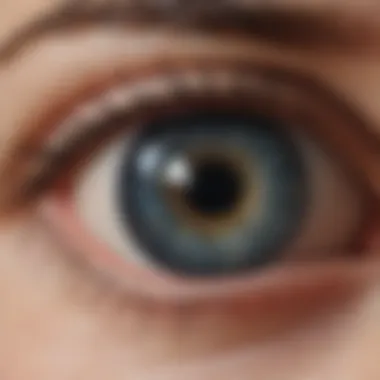
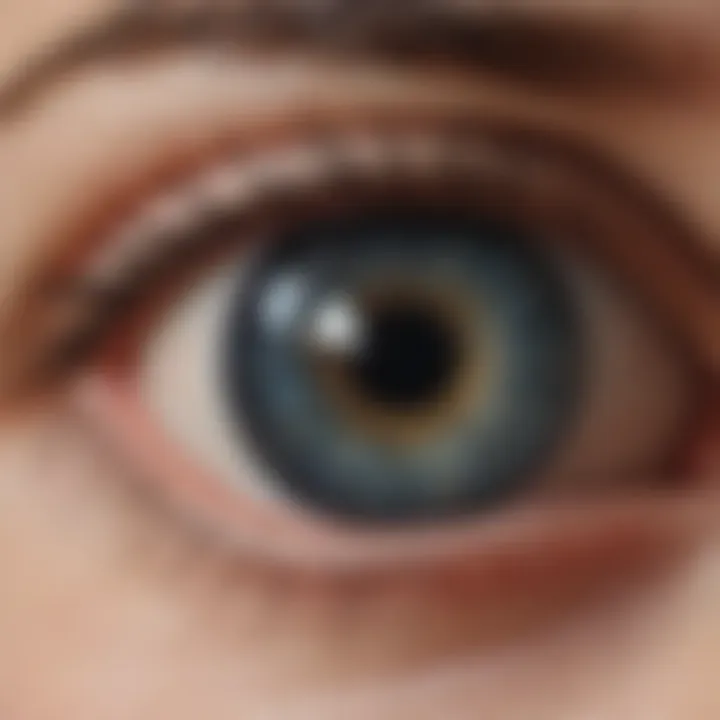
Intro
Corneal erosion, often overlooked, is a critical condition impacting many individuals. This article delves into the intricacies of eroded corneas, exploring how a seemingly simple surface change can lead to significant discomfort and vision issues. A cornea that loses its regular structure—be it from trauma, medical conditions, or environmental factors—can leave people grappling with persistent pain and reduced visual clarity.
Understanding the causes, implications, and potential treatments of corneal erosion is essential for students, researchers, and health professionals alike. Maintaining eye health is a tremendous concern, and even minor issues can escalate if not addressed correctly. Here, we aim to shed light on this complex topic, urging readers to consider both preventive and remedial approaches for better ocular health.
Foreword to Eroded Cornea
Eroded cornea, often overlooked, has a significant impact on an individual’s ocular health and overall quality of life. When we talk about the importance of this topic, we are delving into the intricate relationship between our corneas and our ability to see clearly. The cornea serves as the eye's protective shield and plays a crucial role in refracting light. Thus, understanding its erosion is vital for both medical practitioners and patients alike.
The implications of eroded cornea extend beyond mere discomfort; they can lead to severe vision impairment and even chronic pain if left untreated. This article aims to enlighten you about the various causes behind corneal erosion—ranging from direct trauma to underlying health issues—while also discussing the consequences that could follow an eroded cornea. A knowledgeable insight into treatment options is also imperative, as recognizing available methods can foster hope and encourage timely medical intervention.
Furthermore, the significance of educating oneself about corneal health cannot be ignored. An awareness of eroded cornea can aid in prevention and management of the condition before it escalates into something severe.
"Corneal health shouldn’t be on the back burner; it’s imperative to understand its crucial role in our eyesight and wellbeing."
Defining Eroded Cornea
Eroded cornea occurs when the outermost layers of the cornea, known as the epithelium, lose or become damaged. This erosion can manifest due to a variety of factors such as mechanical injuries, prolonged use of contact lenses, or conditions like dry eye syndrome. When this protective layer is compromised, it opens up the possibility for infections, discords in eyesight, and significant discomfort.
Many people may not realize how critical the corneal structure is until they experience issues firsthand. In a sense, the cornea acts like a gatekeeper, controlling what enters the eye while maintaining a smooth surface for light to pass through. When this surface is disrupted, it can lead to a range of problems that might require clinical attention.
Importance of Corneal Integrity
Maintaining the integrity of the cornea is not just a matter of comfort but also of considerable importance to visual acuity. A healthy cornea is clear, smooth, and distortion-free, ensuring that light bends appropriately as it enters the eye. When erosion occurs, it can result in blurred vision, various shades of discomfort, or even startling sensations of something in the eye—often referred to as foreign body sensations.
The consequences aren't only physical. One's emotional wellbeing might also be affected. Imagine navigating daily tasks such as reading, driving, or simply enjoying a sunset, only to be thwarted by hazy vision. The brain struggles in processing visual information correctly, and this can take a toll on mental health too.
In closing, the introduction to the concept of an eroded cornea emphasizes its multifaceted ramifications and underscores the need for vigilance in eye health. Understanding the intricacies can empower individuals to take proactive measures, ensuring their corneas remain intact and functioning at their best.
Anatomy of the Cornea
Understanding the anatomy of the cornea is paramount when delving into the topic of corneal erosion. The cornea, a transparent layer that covers the front of the eye, plays a crucial role in focusing light and protecting the inner structures. Its unique structure supports both visual function and overall eye health.
Layers of the Cornea
The cornea is composed of five distinct layers, each playing a vital role:
- Epithelium: This outermost layer acts as a protective barrier against environmental factors and pathogens. It’s thin but serves an essential purpose in maintaining moisture and shielding the cornea from injury.
- Bowman's Layer: Beneath the epithelium, this thin layer provides structural support. Its toughness helps protect against minor abrasions.
- Stroma: The thickest part of the cornea, the stroma is made up of collagen fibers that provide strength, shape, and transparency to the cornea. This layer makes the cornea resilient against physical aggression.
- Descemet's Membrane: This thin but strong membrane lies between the stroma and the endothelium. It acts as a protective barrier against infection.
- Endothelium: The innermost layer, endothelial cells regulate fluid balance, ensuring the cornea remains clear and refractive. If these cells are damaged, it can result in swelling and cloudiness.
Through this layered architecture, the cornea manages to refract light, protecting the eye while allowing us to observe the world around us. Understanding these components is significant in identifying how erosion occurs and its impacts on vision.
Functionality of the Cornea
The functionality of the cornea is multifaceted, influencing both vision and health. Here’s how it operates:
- Refraction of Light: The cornea is responsible for approximately 70% of the eye's total focusing power. Its curved surface bends incoming light rays, allowing clear vision at various distances.
- Protection: The cornea safeguards the inner eye from foreign particles, chemicals, and harmful microbes. It also serves as a shock absorber for minor traumas.
- Sensory Reception: It is rich in sensory nerve endings, which contribute to the blink reflex and sense discomfort or foreign bodies, providing a vital line of defense against ocular injury.
- Maintaining Transparency: One of the most crucial jobs of the cornea is to remain clear. The unique arrangement of collagen fibers in the stroma allows light to pass through without scattering. Disruption in layer integrity could result in scarring or opacity, severely impacting vision.
Both the layered structure and diverse functionalities highlight the cornea’s critical role in ocular health. A compromised cornea, such as in cases of erosion, can lead to significant visual disturbances and discomfort, underscoring the importance of maintaining corneal integrity and exploring treatment options.
Causes of Corneal Erosion
Understanding the causes of corneal erosion is crucial for anyone interested in eye health. Recognizing the specific reasons behind this condition can inform better preventive measures and treatment pathways. Corneal erosion doesn’t just stem from a single source; it often results from a cocktail of factors ranging from physical injuries to underlying medical issues. This multifaceted nature highlights the importance of a thorough examination for anyone experiencing symptoms related to corneal damage. Moreover, being aware of these causes empowers individuals to take proactive steps in safeguarding their ocular health.
Trauma and Injury
Trauma is often at the forefront when we discuss causes of corneal erosion. This can happen in numerous ways, and the impact can be immediate or gradual. For instance, a sharp object, like a thorn or a stray particle, might directly scratch the surface of the cornea, leading to discomfort and potential erosion. Activities such as woodworking or playing certain sports can dramatically increase such risks.
Here are key elements to consider regarding trauma:
- Mechanical Injury: A blow to the eye can disrupt the corneal surface, creating small scratches.
- Chemical Exposure: Substances like household cleaners or industrial chemicals can lead to erosive damage if they come into contact with the eye.
- Improper Contact Lens Usage: Wearing contact lenses longer than recommended or not cleaning them properly can increase the risk of abrasions and infections.
It’s vital to approach trauma with caution. If an injury occurs, seeking prompt medical attention is necessary to mitigate further damage.
Underlying Health Conditions
Certain health conditions provide a backdrop to corneal erosion, making it more likely to occur. For instance, illnesses such as diabetes can affect blood circulation, which plays a significant role in corneal healing. When the cornea does not receive adequate nutrients, its resilience diminishes, making it more susceptible to erosive injury.
Other relevant conditions include:
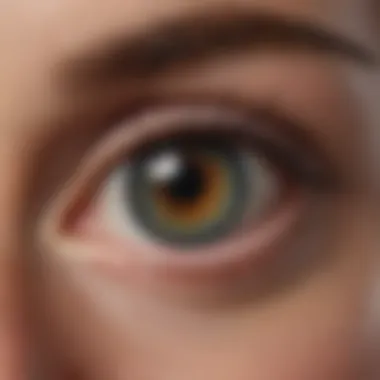
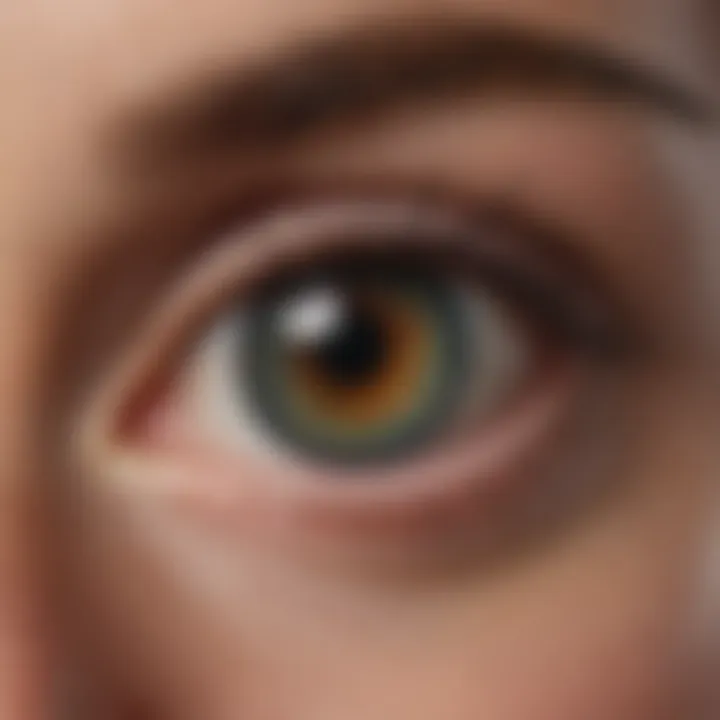
- Dry Eye Syndrome: Insufficient tear production can lead to dryness, increasing the risk of corneal abrasions.
- Blepharitis: Inflammation of the eyelids can result in discomfort, leading to excessive rubbing of the eyes.
- Autoimmune Diseases: Conditions like rheumatoid arthritis or lupus may also contribute to decreased corneal integrity.
Addressing these underlying health issues is key. Treating the primary condition can often alleviate the risk or severity of corneal erosion.
Environmental Factors
The environment in which one lives and works can greatly influence the risk of corneal erosion. Various external factors can wreak havoc on the cornea's surface. Take, for instance, windy or dusty climates that pose threats to eye safety. In such settings, debris can easily enter the eye, and the wind can exacerbate dryness.
Here are some notable environmental elements to keep an eye on:
- UV Exposure: Prolonged sun exposure without adequate eye protection can lead to detrimental effects on the cornea and surrounding tissues.
- Pollution: Airborne irritants can cause inflammation and discomfort, increasing the likelihood of rubbing or injury.
- Occupational Hazards: Workers in fields like construction or manufacturing must be vigilant. Protective eyewear becomes essential in these scenarios to diminish injury risk.
Awareness of these environmental factors means being proactive about eye protection and overall health. The old saying, "an ounce of prevention is worth a pound of cure," truly rings true when it comes to the fragility of our corneal health.
Signs and Symptoms
Recognizing the signs and symptoms of corneal erosion is crucial for early intervention and effective management. The delicate nature of the cornea means that even subtle changes can lead to significant discomfort and impairment if left unaddressed. Understanding these indicators helps not only in diagnosing the condition but also in guiding treatment options effectively. It’s a vital part of protecting one's vision and overall eye health.
Common Symptoms
The initial symptoms of corneal erosion can be quite distressing and often manifest as:
- Increased Sensitivity to Light: As if stepping into a glare-filled room, bright lights can feel harsh on the eyes, leading to discomfort and squinting.
- Excessive Tearing: The eye may overreact, producing more tears than usual in an attempt to alleviate irritation or discomfort.
- Redness in the Eye: Just like any other injured part of the body, the cornea may become inflamed, leading to a characteristic redness.
- Foreign Body Sensation: Individuals may feel as though there is something stuck in their eye, which can be quite bothersome and alarming.
- Blurred Vision: Sometimes, the clarity of vision takes a hit, which can cause anxiety and hinder daily activities.
These symptoms may vary in severity from person to person, but if any of these arise, it’s advisable to seek professional evaluation. The presence of these symptoms can often lead to a diagnosis of corneal erosion, prompting necessary treatment to prevent complications.
Advanced Symptoms and Complications
If corneal erosion progresses without treatment, the symptoms can escalate into more serious complications. Notably, advanced symptoms can include:
- Persistent Eye Pain: What might start as mild irritation can morph into aching or burning sensations, severely affecting one's quality of life.
- Vision Loss: In severe cases, a person may experience significant loss of vision due to scarring or other complications associated with untreated erosion.
- Recurrent Erosions: Some individuals may face multiple episodes of erosions, leading to further damage and necessitating more intricate treatment methods.
- Infections: An eroded cornea might become more susceptible to infections. The risk of developing keratitis, a painful infection of the cornea, increases, making it critical to pay attention to early signs.
"Ignoring early signs can lead to enduring complications, so staying alert is paramount."
Understanding these advanced symptoms underscores the importance of monitoring eye health closely. Anyone experiencing these symptoms should not hesitate to reach out to an eye care professional for comprehensive evaluation and management. Recognizing these signs early could make a world of difference in preserving vision and ensuring a smooth recovery.
Diagnosis of Eroded Cornea
The diagnosis of an eroded cornea is a crucial step in ensuring effective treatment and recovery. Recognizing the intricacies involved in identifying this condition can greatly influence outcomes for affected individuals. Early diagnosis enables clinicians to implement appropriate interventions, which can mitigate complications and enhance the patient's quality of life. The assessment not only involves examining the physical symptoms but also considers the patient's medical history and lifestyle factors that could contribute to corneal erosion.
Clinical Examination Techniques
Clinical examination techniques are the backbone of diagnosing corneal erosion. The first step typically involves a comprehensive eye examination by an ophthalmologist. During this process, several methodologies are employed:
- Slit-Lamp Examination: This is one of the most effective tools used by eye care professionals when assessing the cornea. The slit lamp combines a high-intensity light source with a microscope to offer a detailed view of the cornea’s surface. Through this method, doctors can observe any irregularities, such as defects in the epithelial layer, which are indicative of erosion.
- Fluorescein Staining: After applying a fluorescein dye, practitioners can visualize areas of corneal damage more clearly. When illuminated with a blue light, the dye highlights the erosion, making it easier to assess the extent and severity. This method is especially useful as it provides immediate feedback about the corneas condition.
- Tear Break-Up Time (TBUT): Though primarily utilized to evaluate tear film stability, TBUT can also further inform the understanding of corneal health. A reduced break-up time may suggest that the erosion is associated with recurrent corneal issues, often seen in conditions like dry eye syndrome.
In addition to these techniques, practitioners may also ask patients about any symptoms they are experiencing, such as discomfort, sensitivity to light, or fluctuating vision quality. The confluence of clinical findings and patient feedback serves to create a clearer picture of the situation.
Imaging Studies and Tests
While clinical examinations provide valuable insights, imaging studies and additional tests can enhance diagnostic accuracy further. These may include:
- Corneal Topography: This advanced imaging method constructs a detailed map of the cornea’s surface, allowing healthcare providers to evaluate corneal shape and curvature. Variations in topography can indicate underlying issues that influence the risk of erosion.
- Optical Coherence Tomography (OCT): OCT offers high-resolution imaging of the cornea and its layers. This technology allows for a non-invasive assessment, enhancing the understanding of structural changes that may not be visible through conventional examination methods.
- Pachymetry: This technique evaluates corneal thickness, which can provide insights into conditions that predispose individuals to erosion. Thin corneas are often more susceptible to damage and erosion due to increased fragility.
The importance of diagnosing an eroded cornea cannot be overstated. Early detection is key to preventing potential complications, such as chronic pain or severe visual impairment. Through a combination of clinical assessments and advanced imaging techniques, healthcare providers can devise individualized treatment plans that are most effective for each patient's unique situation.
"As we unravel the layers of the cornea, a clearer picture emerges of the condition's status and path forward."
In closing, staying informed about the diagnostic processes involved in corneal erosion can significantly empower patients and caregivers alike. Better awareness leads to faster identification of symptoms and encourages timely medical attention, ultimately fostering healthier ocular outcomes.
Treatment Options for Eroded Cornea
Addressing an eroded cornea necessitates a nuanced understanding of various treatment avenues. Each pathway plays a distinct role in alleviating symptoms and fortifying the cornea against further damage. Recognizing the various treatment options not only aids in effective management but also emphasizes the need for careful consideration of patient-specific factors in crafting the right approach.
Conservative Management
Conservative management typically serves as the first line of defense against corneal erosion. This segment comprehensively explores several structures that can help in minimizing discomfort and facilitating the healing process.
Topical Medications
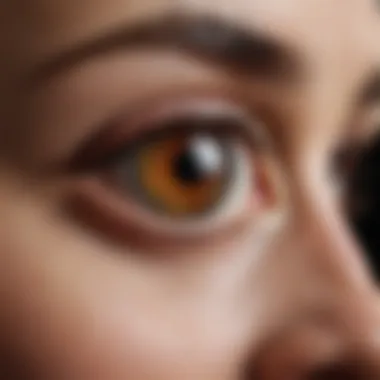
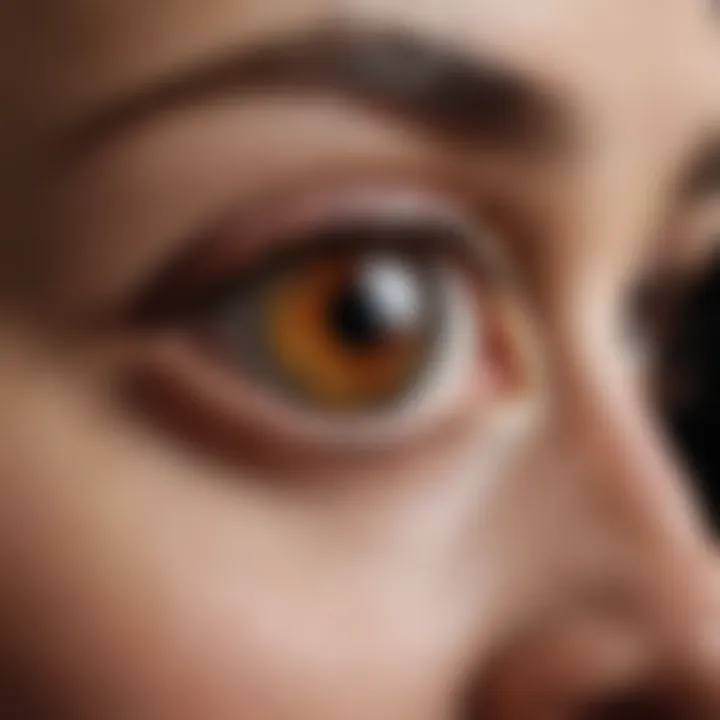
Topical medications stand out as a primary method for addressing symptoms associated with corneal erosion. These medications may include antibiotics to thwart infection, lubricating drops to ease discomfort, and other medicated solutions tailored to promote healing. One key characteristic of these medications is their direct application to the affected area, enabling targeted relief.
The unique feature of topical medications lies in their rapid action and convenience. Patients often find them easy to use without needing invasive procedures. However, this approach can have a couple of notable drawbacks, such as possible allergy or sensitivity to certain ingredients, necessitating close monitoring during the treatment phase.
Protective Eyewear
Protective eyewear is another significant element in conservative management. Its primary role is to shield the eyes from environmental hazards, particularly during activities that may lead to injury or irritation. A crucial aspect of protective eyewear is its accommodation of various environments, whether indoors or outdoors, offering versatile protection.
This unique feature not only minimizes exposure to potential irritants but also may enhance comfort for individuals with heightened sensitivity. On the flip side, some users may find wearing protective eyewear uncomfortable or cumbersome, particularly during prolonged use, which can lead to inconsistent adherence to this preventive measure.
Hydration and Nutrition
Hydration and nutrition might not be the first thing that comes to mind when considering corneal health, yet they've got a vital role in the overall healing process. Maintaining optimal hydration helps lubricate not only the eyes but the entire body, aiding in recovery. A key characteristic is the synergistic effect of hydration combined with nutrient-rich foods that promote tissue repair and overall well-being.
The unique advantage of focusing on hydration and nutrition is that it’s a holistic approach, contributing to dwindling irritation and ensuring the body has the necessary resources to heal from the inside out. However, it’s important to note that immediate changes might not provide the quick relief one could seek in acute situations, thereby requiring some patience from the patient.
Surgical Interventions
When conservative measures do not yield the desired results or when the erosion is severe, surgical interventions become a necessary consideration. These options can provide more permanent solutions to the issues stemming from corneal erosion, and each carries its own unique benefits and risks.
Corneal Transplantation
Corneal transplantation represents a significant leap towards restoring vision and integrity to the eye. This procedure involves the replacement of a damaged cornea with a healthy donor cornea, a key feature that can lead to dramatic improvements. Its benefit lies in addressing not just erosion but any accompanying complications such as structural weakness.
A unique aspect of corneal transplantation is its potential to correct underlying conditions leading to erosion, although the surgery is major and inherently carries risks such as rejection of the donor tissue. Moreover, post-surgery patients must commit to long-term follow-up and often immunosuppressive therapy, which can deter some potential candidates.
PTK (Phototherapeutic Keratectomy)
PTK, or Phototherapeutic Keratectomy, offers another surgical route that focuses specifically on reshaping the cornea’s surface. This laser treatment works by removing superficial layers where erosion and damage exist, essentially smoothing out irregularities. A key aspect of PTK is its non-invasive nature, as it often requires just topical anesthesia.
What sets PTK apart is its focused application on corneal surface irregularities while preserving deeper layers. The down side, however, is that it may not be suitable for all patients, particularly those with significant underlying conditions that might complicate recovery. Additionally, some might experience longer than usual recovery times compared to more straightforward procedures.
Recovery Strategies
Recovery strategies play a pivotal role in ensuring the healing of the cornea after an erosion incident. The cornea, being the window to the eye, requires meticulous care during the recovery phase to prevent complications and to promote optimal healing. Effective recovery strategies not only facilitate the mending of the corneal surface but also help restore vision and comfort in daily activities. Engaging in proper post-treatment care and adhering to follow-up appointments can significantly enhance the recovery process.
Post-Treatment Care
After treatment for corneal erosion, whether it be conservative management or surgical intervention, post-treatment care is crucial. This phase often involves multiple key elements to ensure recovery is smooth and effective:
- Protective Measures: Patients are often advised to wear protective eyewear to shield their eyes from potential irritants and injuries. This could be a pair of sunglasses or specialized goggles, depending on their environment.
- Medications: Topical medications, such as lubricating eye drops or anti-inflammatory solutions, are typically prescribed. These help manage discomfort and promote healing by ensuring the cornea remains hydrated. It is essential to follow the prescribed schedule closely.
- Avoidance of Irritants: Keeping away from smoke, dust, and other irritants can prevent additional strain on the cornea. An eye that has experienced erosion is particularly sensitive, and protecting it from harm is vital.
- Rest: Giving the eyes adequate rest, including reducing screen time and avoiding strenuous activities, can help expedite healing.
In this stage, paying attention to any changes in symptoms is paramount. If new discomfort arises or existing symptoms worsen, it is crucial to reach out to an eye care professional without delay.
Follow-Up Appointments
Follow-up appointments are the backbone of recovery strategies following corneal erosion. These visits allow healthcare providers to monitor healing progress and intervene promptly if complications arise. They typically encompass the following:
- Evaluating Healing: During these visits, an eye specialist conducts a thorough examination of the cornea. Using tools like slit-lamp microscopy, they assess the integrity of the cornea and check for signs of infection or scarring.
- Adjusting Treatment Plans: Based on the healing status observed, doctors can adjust medications or suggest new strategies to aid recovery. This adaptability is crucial since each individual’s healing journey is different.
- Monitoring Vision Changes: Changes in vision are a flag for follow-up discussions. Eye care providers will evaluate if the treatment is effective or if further interventions are necessary.
- Patient Education: These appointments also serve as an opportunity to reinforce education around issues related to corneal health. Understanding the importance of preventative measures can empower patients to take proactive steps moving forward.
"Monitoring and consistent follow-ups can vastly improve the outcomes after corneal erosion treatment"
Prevention of Corneal Erosion
Preventing corneal erosion is vital for maintaining overall eye health and ensuring optimal visual function. Eroded cornea can lead to a plethora of issues, not only affecting one’s sight but also causing significant discomfort and impaired quality of life. This section dives into specific strategies aimed at limiting the occurrence of corneal erosion, highlighting the benefits of proactive measures and the necessary considerations for effective prevention.
Protective Measures
Utilizing protective measures is essential in safeguarding the cornea from erosion. Here are several effective strategies:
- Wear Protective Eyewear: Engaging in activities that put the eyes at risk, such as sports or working with hazardous materials, warrants the use of protective eyewear. Goggles or safety glasses can shield the eyes from potential injuries that could lead to corneal erosion. As the saying goes, "an ounce of prevention is worth a pound of cure"—this holds particularly true for eye protection.
- Maintain Proper Hygiene: Good hygiene practices play a significant role in preventing corneal issues. Regularly washing hands, especially before touching the face or eyes, can reduce the risk of infection. Similarly, keeping contact lenses clean and adhering to prescribed wear times will help protect the cornea.
- Control Environmental Factors: High wind, dust, and smoke can exacerbate eye irritation. Using sunglasses in harsh weather conditions can help shield the eyes from these elements. Humidifiers may also be beneficial in managing dry air environments, particularly during winter months.
- Monitor Health Conditions: Conditions like dry eye syndrome or diabetes can contribute to corneal erosion. Regular check-ups with healthcare professionals can ensure that these underlying issues are managed effectively, reducing the likelihood of corneal damage.
Education and Awareness
Awareness of the risk factors and symptoms of corneal erosion is crucial for effective prevention. Educating oneself and the community can empower individuals to take necessary precautions. Here’s how awareness can impact prevention:
- Community Outreach Programs: Hosting or participating in community workshops can spread knowledge about corneal health. Information on protective measures, signs of erosion, and treatment options foster a more health-conscious public.
- Educational Resources: Providing easily accessible resources, such as brochures or online articles, can disseminate important information about corneal health. Those with an interest in ophthalmology, such as students and healthcare professionals, may benefit from understanding the complexities of corneal erosion.
- Utilizing Technology: Online platforms—like forums on Reddit or educational posts on Facebook—can facilitate discussions about preventative strategies and experiences. Sharing personal stories can create a relatable context, allowing others to learn from various situations.
- Encouraging Regular Eye Exams: Routine eye examinations can catch potential issues before they escalate. Patients should be informed about this necessity during consultations, reinforcing the value of preventive care.
"Awareness is the key to prevention; knowing what to look for can make all the difference".
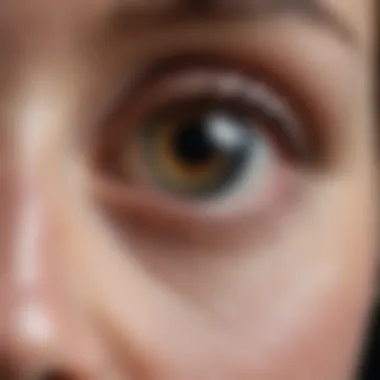
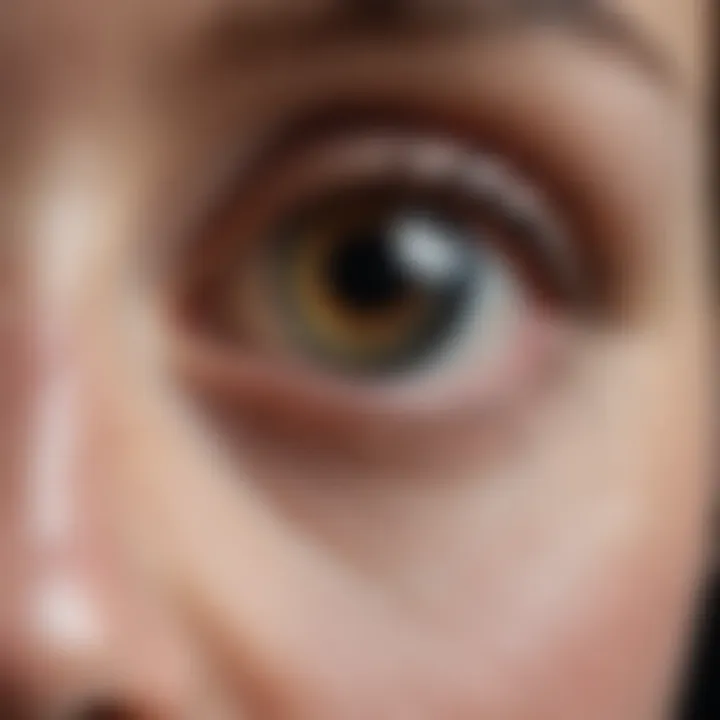
Impact of Eroded Cornea on Quality of Life
When the cornea endures erosion, its impact extends into various aspects of life that might not be immediately apparent. Understanding this facet is essential because it underscores the multifaceted nature of corneal health. Affected individuals often navigate a myriad of challenges that can touch their emotional well-being and daily routines, making it crucial to recognize these impacts in a comprehensive article on corneal erosion.
Emotional and Psychological Effects
Eroded cornea can deeply influence a person’s emotional state. The discomfort caused by the erosion might lead to feelings of frustration or helplessness. Continuous pain or irritation can wear down an individual’s patience, causing increased anxiety levels. Picture this: you try to watch your favorite show or read a book, yet constant stinging in your eye distracts you, making it feel like a chore to focus on anything else.
Moreover, as one grapples with the anxiety of potential vision loss, the psychological load can become hefty. An individual might start withdrawing from social situations, fearing that they cannot engage fully due to discomfort or blurred vision. It's like walking on eggshells—trying to balance the desire to partake in daily life against the fear of increased pain or embarrassment.
"The emotional toll of living with an eroded cornea may not be visible, but it is undeniably real, affecting confidence and quality of relationships."
Effects on Daily Activities
The repercussions of an eroded cornea extend into the nitty-gritty of everyday life. Even simple tasks can become Herculean. Consider how often we rely on vision—whether it’s driving to work, scrolling through social media, or even cooking. Each of these activities may become fraught with struggles for someone dealing with corneal erosion.
- Visual Discomfort: With repeating strain from the affected eye, one might experience sensitivity to light, making bright days feel unbearable.
- Diminished Productivity: For students or professionals, a drop in concentration or clarity can lead to falling behind in tasks. How can you write a paper or meet deadlines with an eye that's constantly bothering you?
- Compromised Safety: Engaging in activities that require fine motor skills, like cooking or using tools, can pose a risk. If vision blurs unexpectedly, accidents may be waiting to happen.
As the erosion continues, people might find themselves rethinking how they engage with their surroundings. A vibrant life could feel more confined, reinforcing the need for proactive treatment and social support in facing these challenges. Tackling both the mental and physical hurdles associated with an eroded cornea is pivotal for the enhancement of life quality.
Research and Innovations in Corneal Health
Research in the field of corneal health has become absolutely critical as we look to not only understand but combat the issues surrounding conditions such as corneal erosion. This area of inquiry is vital for several reasons: it enhances the overall knowledge about corneal structure and functions, promotes the development of advanced treatment modalities, and ultimately aims to improve the quality of life for individuals affected by corneal diseases. The stakes are high because even minor deterioration in corneal integrity can lead to significant visual impairment, making this research imperative for eye health specialists and caregivers alike.
As we navigate through this complex topic, it’s essential to consider the multifaceted benefits of ongoing research. Here are a few key aspects:
- Innovation in Treatment: New technologies allow for the development of less invasive treatment options. For example, innovations in laser therapies and regenerative medicine offer the potential to significantly improve the restoration of corneal function.
- Patient-Centered Care: Research helps in understanding individual patient needs, facilitating the customization of treatment plans to match specific conditions and lifestyles.
- Preventative Strategies: Investigations into the root causes of corneal issues can lead to effective prevention strategies, thus reducing incidence rates and associated complications.
Research isn't just a way to treat existing problems but is also crucial for anticipating challenges in the future, especially as populations age or as environmental factors change.
Current Trends in Research
At present, the landscape of corneal health is vibrant with several exciting trends that showcase the determination of researchers to improve outcomes. One notable trend is the rise in gene therapy, which seeks to address genetic disorders that affect corneal integrity. This innovative approach outlines a future where potentially debilitating conditions may be treated at a molecular level. Another significant focus is on biomaterials, specifically the exploration of new materials for contact lenses and eye drops that promote healing without additional irritation.
Additionally, the application of artificial intelligence (AI) in diagnostics is gaining traction. AI can analyze various parameters in ocular imaging, thus providing more accurate and timely diagnoses of corneal problems. This, in turn, allows for swift intervention, which is critical in preventing the progression of corneal erosion.
Of course, researchers are also actively engaged in examining the impact of environmental factors, such as pollution and climate change, on corneal health. This discourse is particularly timely given the growing concerns about public health as environmental issues become central to global discussions.
Future Directions in Treatment
Looking ahead, there are several promising pathways in the treatment of corneal conditions that could revolutionize patient care. One such direction is stem cell therapy. Researchers are investigating how these cells can be harnessed to repair and regenerate damaged corneal tissues. This could provide tremendous relief for patients suffering from chronic erosive conditions.
Another innovative approach on the horizon is the integration of nanotechnology. This technology aims to deliver medications more effectively, ensuring targeted treatment and minimal side effects. Furthermore, innovations in implants and devices, such as smart lenses that can adjust focus or deliver medication, could change the way we think about corneal treatments.
"The future of corneal health treatment lies in combining innovative techniques and a patient-centric approach to tackle and prevent disease effectively."
Lastly, the emphasis on multidisciplinary collaboration will drive future advancements. Cooperation between eye care professionals, researchers, and technologists will be essential to create comprehensive strategies that address the challenges posed by corneal diseases.
Finale
The conclusion is a pivotal point in any discussion regarding eroded cornea, tying together the various facets explored throughout this article. Understanding the impact of corneal erosion is essential for both eye health practitioners and patients. Firstly, the recognition of the different causal factors—from trauma and health conditions to environmental influences—allows for a more comprehensive preventive strategy. By identifying these factors, individuals can take proactive steps to preserve corneal integrity and optimize their eye health.
Moreover, as the article highlighted, the consequences of an eroded cornea go beyond mere discomfort. The risk of complications, such as vision impairment, can have lasting effects on one’s quality of life. This factor elevates the importance of timely diagnosis and treatment, emphasizing that this topic is not just an academic exercise but a pressing health concern.
Finally, the treatment options, whether conservative or surgical, provide valuable avenues for recovery. Understanding these options equips both patients and healthcare providers with the knowledge necessary to make informed decisions regarding care strategies. In light of this, the conclusion underscores the vital need for ongoing education and discussion surrounding corneal health, ensuring that those affected by this condition are well-equipped to navigate their recovery and future prevention effectively.
Summary of Key Points
- Corneal Erosion Causes: Identifies key triggers including trauma, underlying health issues, and environmental factors.
- Impact on Vision: Covers the potential risks and complications resulting from an eroded cornea.
- Treatment Options: Summarizes conservative and surgical interventions available to address corneal erosion.
- Prevention and Education: Stresses the importance of awareness and educational measures in mitigating risk.
Final Thoughts and Recommendations
Understanding the complexities of corneal erosion demands a multifaceted approach. Stakeholders, including healthcare professionals, educators, and patients, must collaborate to foster an environment of awareness and proactive health measures.
Recommendations include:
- Regular Eye Examinations: Schedule comprehensive eye exams to catch early signs of corneal issues.
- Protective Eyewear: Use suitable eyewear to safeguard against potential injuries, particularly in hazardous environments.
- Awareness Programs: Promote educational initiatives focusing on prevention strategies and treatment options.
Emphasizing the need for both knowledge and action, these strategies can help thwart the development of corneal erosion and its associated complications, thereby improving both individual and community eye health.
Citations for Further Reading
For those interested in expanding their understanding of corneal health, we recommend the following resources:
- Wikipedia on Corneal Erosion
- Britannica: Corneal Disorders
- Additionally, joining discussions on platforms like Reddit or following groups on Facebook can provide real-time insights and experiences from professionals and patients alike.



